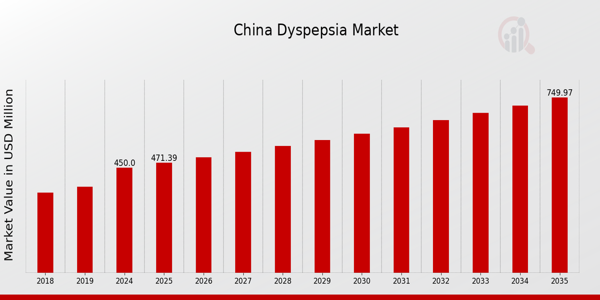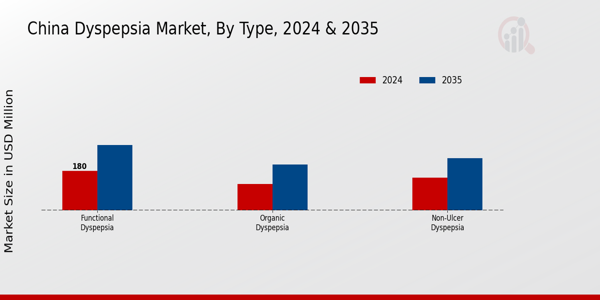China Dyspepsia Market Overview
As per MRFR analysis, the China Dyspepsia Market Size was estimated at 408 (USD Million) in 2023.The China Dyspepsia Market Industry is expected to grow from 450(USD Million) in 2024 to 750 (USD Million) by 2035. The China Dyspepsia Market CAGR (growth rate) is expected to be around 4.753% during the forecast period (2025 - 2035).
Key China Dyspepsia Market Trends Highlighted
The increasing healthcare awareness and changing lifestyles of the population are driving significant trends in the China Dyspepsia Market. The demand for effective dyspepsia treatments has increased as a result of the increasing prevalence of gastrointestinal issues associated with stress and diet. More individuals are pursuing over-the-counter medications and natural remedies available in traditional Chinese medicine, reflecting a blend of modern and conventional therapeutic practices as a result of a shift toward self-medication. This trend has been accelerated by the government's advocacy for integrated healthcare systems, which promotes the use of herbal remedies in conjunction with pharmaceutical alternatives and supports holistic health approaches.
There are considerable opportunities to be exploited in rural areas that have yet to be explored, as healthcare accessibility remains restricted. The development of targeted educational programs and marketing strategies in these regions has the potential to increase awareness and access to dyspepsia solutions. Additionally, there is potential for the expansion of distribution channels throughout the country as e-commerce platforms dedicated to dyspepsia products become more prevalent in urban areas as online pharmacies continue to acquire popularity. The emergence of innovative formulations and product lines that are specifically designed to address functional dyspepsia in recent times has underscored a shift toward personalized medicine in China.
The country's overall health standards are being enhanced through a variety of governmental initiatives that support research and development in this field. In addition, the rise of medical tourism has facilitated the exchange of knowledge, elevating international dyspepsia treatments to the forefront of consumer awareness in China. In general, these trends are indicative of a changing market landscape that is adapting to the diverse preferences and requirements of Chinese consumers who are afflicted with dyspepsia.

Source: Primary Research, Secondary Research, Market Research Future Database and Analyst Review
China Dyspepsia Market Drivers
Increasing Prevalence of Dyspepsia Among Chinese Population
The increasing prevalence of dyspepsia among the Chinese population is a significant driver for the China Dyspepsia Market Industry. With lifestyle changes and dietary habits evolving rapidly, studies have indicated that approximately 20% of the adult population in China suffers from dyspepsia symptoms. This figure is supported by research reported in national health surveys, indicating a rise in gastrointestinal conditions, partly attributable to the consumption of processed and fast food, which has escalated over the last two decades.
Furthermore, the China National Health Commission has been actively addressing this issue, promoting campaigns to raise awareness about gastrointestinal health, which is likely to lead to increased demand for dyspepsia treatments. Major organizations like the Chinese Medical Association are also contributing to the development of better treatment protocols and therapies, thereby influencing the growth of the China Dyspepsia Market.
Growing Awareness of Gastrointestinal Health
There is a growing awareness regarding gastrointestinal health in China, significantly contributing to the growth of the China Dyspepsia Market Industry. Recent health initiatives launched by the Chinese government and health agencies emphasize the importance of gastrointestinal health management.
A survey conducted by the Ministry of Health indicated that around 62% of the participants had gained improved knowledge about symptoms and treatment options for dyspepsia.This rise in awareness leads to earlier diagnosis and increased treatment-seeking behavior among the population. Consequently, this heightened awareness creates an expanded market for dyspepsia medications and therapies bolstered by ongoing education and outreach programs.
Advancements in Treatment Options
Advancements in treatment options for dyspepsia are a crucial driver of growth in the China Dyspepsia Market Industry. The introduction of innovative therapies and medications has enhanced treatment efficacy, with many new drugs receiving approval from the National Medical Products Administration (NMPA) in China.
For instance, research shows that gastrointestinal medications have advanced significantly over the last 5 years, resulting in a higher success rate of treatment for dyspepsia-related conditions, with studies indicating up to a 35% increase in treatment satisfaction among patients.This progress not only boosts clinical practice but also draws investments from pharmaceutical companies looking to expand their portfolios in the growing market, thereby further driving market growth.
China Dyspepsia Market Segment Insights
Dyspepsia Market Type Insights
The China Dyspepsia Market, categorized by Type, encompasses key classifications such as Functional Dyspepsia, Non-Ulcer Dyspepsia, and Organic Dyspepsia. This segmentation plays a vital role in understanding the various facets and complexities of dyspepsia, a common digestive disorder affecting a significant portion of the population in China. Functional Dyspepsia, known for its link to gastrointestinal discomfort without any evident structural cause, is notably prevalent in urban areas, attributed to the fast-paced lifestyle and dietary habits of the Chinese population. Non-Ulcer Dyspepsia is characterized by indigestion without the presence of ulcers, and it often presents a challenge in diagnosis due to its ambiguous nature, further emphasizing the need for improved diagnostic techniques and patient education.
Organic Dyspepsia, on the other hand, can be associated with identifiable physical conditions like gastritis or peptic ulcers, thus requiring distinct management and treatment approaches. The distinct characteristics and contributing factors tied to these types of dyspepsia underscore the necessity for targeted intervention strategies and the development of specific therapeutics. As healthcare institutions in China increasingly prioritize digestive health, there is a growing trend towards understanding and addressing these specific types of dyspepsia. Awareness programs and lifestyle modifications are becoming essential in managing symptoms effectively.
Furthermore, the increasing prevalence of unhealthy eating habits, such as the consumption of spicy and oily foods, has fueled the rising incidences of dyspepsia across the country. These trends provide significant opportunities for pharmaceutical companies and research entities to innovate and develop solutions tailored to the specific type of dyspepsia experienced by populations in diverse regions of China. Overall, the Type-based segmentation of the China Dyspepsia Market not only highlights the different manifestations of this disorder but also stresses the need for enhanced research, clinical guidelines, and patient management solutions to improve health outcomes in the affected populations. These insights play an essential role in shaping market strategies and addressing the growing concerns surrounding dyspepsia within the country.

Source: Primary Research, Secondary Research, Market Research Future Database and Analyst Review
Dyspepsia Market Treatment Type Insights
The Treatment Type segment of the China Dyspepsia Market plays a crucial role in addressing the needs of the population experiencing dyspeptic symptoms, which include discomfort and pain in the upper digestive tract. Within this segment, Antacids are widely used due to their effectiveness in neutralizing stomach acid, thus providing immediate relief to patients. Proton Pump Inhibitors (PPIs) have gained prominence as they reduce acid production, making them significant for long-term management of dyspepsia.
H2-receptor antagonists also contribute to the management of dyspepsia by inhibiting stomach acid secretion and are favored for their efficacy and safety profile.Prokinetics, on the other hand, assists in improving gastrointestinal motility, thus alleviating symptoms by facilitating digestion and transit. The growing prevalence of dyspepsia in China, driven by dietary changes and lifestyle factors, significantly impacts the demand for these treatment types. Moreover, increasing healthcare awareness and access to medications contribute to the market's evolution. The ongoing advancements in drug formulations and the development of novel therapies further enhance the treatment options available, creating opportunities for growth within the industry.
Dyspepsia Market Route of Administration Insights
The China Dyspepsia Market is characterized by diverse routes of administration, which significantly influence treatment regimens and patient adherence. The oral route predominates due to its convenience and ease of use, making it the first choice for many patients seeking relief from dyspeptic symptoms. Injectable medications, while less common, provide critical alternatives for patients who may have difficulty swallowing or who require rapid action. This route enables healthcare providers to manage symptoms effectively in severe cases. The topical route, though less common in dyspepsia treatment, offers innovative delivery methods that can potentially enhance patient comfort and compliance.
The varying preferences for these routes are shaped by factors such as patient demographics, regional healthcare practices, and the clinical efficacy of available treatments. Increasing healthcare awareness and improvements in drug formulations are expected to further drive the evolution of these routes of administration in the China Dyspepsia Market, creating opportunities for growth in both conventional and novel treatment approaches. The overall segmentation of routes of administration reflects the market's adaptability to patient needs, showcasing the emphasis placed on effective symptom management within the dyspepsia treatment landscape.
Dyspepsia Market Distribution Channel Insights
The Distribution Channel segment of the China Dyspepsia Market presents a diverse landscape with key players, including Hospital Pharmacies, Retail Pharmacies, and Online Pharmacies. Hospital Pharmacies play a critical role in providing specialized medication for dyspepsia, ensuring patients have access to prescription-only products while often receiving clinical support from healthcare professionals. Retail Pharmacies serve as accessible points for over-the-counter treatments, catering to the general public's immediate needs and preferences. The rise of Online Pharmacies highlights a significant trend driven by the increasing digitalization and convenience of e-commerce platforms, allowing patients to order medications from the comfort of their homes.
The growth of Online Pharmacies is especially notable as consumer behavior shifts towards online shopping, bolstered by the availability of various payment options and delivery services. Together, these channels contribute to a dynamic framework that effectively addresses the demands of dyspepsia management in China, reflecting the broader trends of healthcare accessibility and the evolving pharmaceutical landscape within the nation. Increasing awareness about dyspepsia, supportive government initiatives, and the growing population in need of efficient healthcare solutions further solidify the importance of these distribution channels in the market.
China Dyspepsia Market Key Players and Competitive Insights
The China Dyspepsia Market has seen significant developments over the years, reflecting a growing understanding of gastrointestinal disorders among the population. As healthcare facilities expand and innovative therapeutic solutions emerge, the market dynamics have become increasingly competitive. Various pharmaceutical companies are actively engaged in developing and marketing products that target dyspepsia, catering to a rising demand driven by lifestyle changes and dietary habits. Companies are investing in research and development to introduce new formulations and treatment options to address the specific needs of patients suffering from dyspepsia in China. This competitive landscape is characterized by a blend of domestic players and multinational corporations, all striving to enhance their market share and improve patient outcomes through effective products.
Zhejiang Jiahua Pharmaceutical has positioned itself as a prominent player in the China Dyspepsia Market with a strong focus on developing innovative treatment solutions tailored to local needs. The company's strategic emphasis on research and development has led to the formulation of various effective medications aimed at alleviating dyspeptic symptoms. Zhejiang Jiahua Pharmaceutical benefits from its established distribution networks across the country and a commitment to high-quality manufacturing standards that bolster its reputation. The firm leverages its deep understanding of the Chinese healthcare system and regulations to optimize its market presence, ensuring that its products are accessible to a wide audience. This combination of innovation, quality assurance, and extensive market knowledge serves as a significant strength for Zhejiang Jiahua Pharmaceutical in a competitive field.
Guangzhou Baiyunshan Pharmaceutical Holdings holds a robust position in the China Dyspepsia Market, recognized for its diverse portfolio of products aimed at gastrointestinal health. The company offers a range of key products that address dyspepsia symptoms, supported by a strong commitment to research and effective marketing strategies. Guangzhou Baiyunshan Pharmaceutical Holdings benefits from a well-established market presence, bolstered by its initiatives in mergers and acquisitions that have enhanced its product line and distribution capabilities. The company's strengths lie in its operational excellence, supply chain efficiency, and advanced research initiatives that keep it at the forefront of addressing dyspepsia in China. Moreover, its collaborations with healthcare providers and institutions further amplify its ability to cater to the evolving demands of consumers in the dyspepsia segment, enhancing its competitive edge in the market.
Key Companies in the China Dyspepsia Market Include:
- Zhejiang Jiahua Pharmaceutical
- Guangzhou Baiyunshan Pharmaceutical Holdings
- Harbin Pharmaceutical
- Qilu Pharmaceutical
- Sino Biopharmaceutical
- Beijing Tongrentang
- HengRui Medicine
- Shanghai Pharmaceuticals
- Yiling Pharmaceutical
- China National Pharmaceutical Group
- Jiangsu Hengrui Medicine
- Shenzhen Hepalink Pharmaceutical
- Xiangxue Pharmaceutical
- Fosun Pharmaceutical
China Dyspepsia Market Industry Developments
The China Dyspepsia Market has seen notable developments lately, particularly with a surge in product innovations and the introduction of new treatment options by major players such as Zhejiang Jiahua Pharmaceutical and Guangzhou Baiyunshan Pharmaceutical Holdings. In September 2023, Harbin Pharmaceutical revealed advancements in its gastrointestinal medication line, positioning the company for increased market share.
Moreover, Qilu Pharmaceutical recently enhanced its R&D efforts, focusing on improving efficacy and patient outcomes. Industry analysts are noting a growth pattern, with expectations of a market valuation increase driven by rising dyspepsia cases linked to lifestyle changes in urban areas.In terms of mergers and acquisitions, Sino Biopharmaceutical announced in July 2023 the acquisition of a specialty drug firm specializing in digestive health solutions aimed at expanding its product portfolio.
Similarly, Beijing Tongrentang's strategic partnership with Shenzhen Hepalink Pharmaceutical in August 2023 has enriched its therapeutic offerings. Companies like Yiling Pharmaceutical and China National Pharmaceutical Group continue to expand their market footprint through innovative collaboration while navigating regulatory landscapes. These dynamics are reshaping the competitive environment within the China Dyspepsia Market, ultimately benefiting patient care and treatment accessibility.
China Dyspepsia Market Segmentation Insights
Dyspepsia Market Type Outlook
- Functional Dyspepsia
- Non-Ulcer Dyspepsia
- Organic Dyspepsia
Dyspepsia Market Treatment Type Outlook
- Antacids
- Proton Pump Inhibitors
- H2-Receptor Antagonists
- Prokinetics
Dyspepsia Market Route of Administration Outlook
Dyspepsia Market Distribution Channel Outlook
- Hospital Pharmacies
- Retail Pharmacies
- Online Pharmacies
| Report Attribute/Metric Source: |
Details |
| MARKET SIZE 2023 |
408.0(USD Million) |
| MARKET SIZE 2024 |
450.0(USD Million) |
| MARKET SIZE 2035 |
750.0(USD Million) |
| COMPOUND ANNUAL GROWTH RATE (CAGR) |
4.753% (2025 - 2035) |
| REPORT COVERAGE |
Revenue Forecast, Competitive Landscape, Growth Factors, and Trends |
| BASE YEAR |
2024 |
| MARKET FORECAST PERIOD |
2025 - 2035 |
| HISTORICAL DATA |
2019 - 2024 |
| MARKET FORECAST UNITS |
USD Million |
| KEY COMPANIES PROFILED |
Zhejiang Jiahua Pharmaceutical, Guangzhou Baiyunshan Pharmaceutical Holdings, Harbin Pharmaceutical, Qilu Pharmaceutical, Sino Biopharmaceutical, Beijing Tongrentang, HengRui Medicine, Shanghai Pharmaceuticals, Yiling Pharmaceutical, China National Pharmaceutical Group, Jiangsu Hengrui Medicine, Shenzhen Hepalink Pharmaceutical, Xiangxue Pharmaceutical, Fosun Pharmaceutical |
| SEGMENTS COVERED |
Type, Treatment Type, Route of Administration, Distribution Channel |
| KEY MARKET OPPORTUNITIES |
Growing prevalence of dyspepsia cases, Increased demand for OTC treatments, Expansion of telehealth services, Rising adoption of gut health supplements, Innovative diagnostic technologies emergence |
| KEY MARKET DYNAMICS |
rising prevalence of dyspepsia, increasing awareness of gastrointestinal health, growth of OTC medication sales, expansion of healthcare access, preference for natural remedies |
| COUNTRIES COVERED |
China |
Frequently Asked Questions (FAQ):
The China Dyspepsia Market is expected to be valued at 450.0 USD Million in 2024.
By 2035, the overall market value for the China Dyspepsia Market is projected to reach 750.0 USD Million.
The expected CAGR for the China Dyspepsia Market from 2025 to 2035 is 4.753%.
Functional Dyspepsia is expected to be the largest segment, projected to be valued at 300.0 USD Million by 2035.
Non-Ulcer Dyspepsia is projected at 240.0 USD Million, while Organic Dyspepsia is projected at 210.0 USD Million by 2035.
Major players in the market include Zhejiang Jiahua Pharmaceutical, Guangzhou Baiyunshan Pharmaceutical Holdings, and Harbin Pharmaceutical among others.
Growing awareness of dyspepsia treatments and increasing prevalence of gastrointestinal disorders are key growth drivers in the market.
The competitive landscape is characterized by several prominent players striving for market share amid increasing consumer demand.
Challenges may include stringent regulatory frameworks and market saturation hindering growth opportunities.
The market for Functional Dyspepsia is expected to grow significantly, reflecting its status as a dominant segment in the China Dyspepsia Market.





















